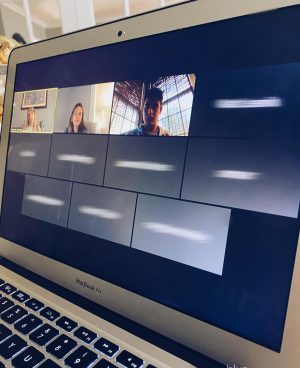Great Debate: Cameras Off
December 4, 2020
You roll out of bed. Your hair is a mess, you look terrible, you feel tired.
“Cameras on!” are not the two words you want to hear.
Students at the high school are against cameras, according to an independent survey from the Crimson. While students do not look disheveled all day, this anti-camera sentiment remains true for even the times when students are alert, awake, and looking their best. These feelings against cameras are rooted in the opinions of high school during the pandemic and reflected throughout the student population.
Cameras should not be required for a host of reasons, some of which are out of student control – which the school policy recognizes – while other ethical reasons come into play.
Dr. Neigel explains the high school’s camera policy is to “encourage” students to have their cameras on, but the administration recognizes that a number of students’ “home learning environments” make it difficult or impossible for them to show themselves or their surroundings. For example, a student who has multiple siblings on online meetings simultaneously in the same room would be put in a difficult situation if all were required to have their cameras on, and the result of this would be less concentration and more concern about surroundings.
This seems like a beneficial policy to adopt and use, as forcing students’ cameras ‘on’ would seem like a privacy issue, as students are in their own homes. As long as students participate to satisfy the teacher, they should not have to be spied upon in the safety of their own bedroom or basement.
Another interesting point against the eye of the computers comes from the voices of students themselves. The overwhelming majority of respondents to a survey from The Crimson – roughly 85% of students, representative of the entire student body – professed that they learn the same or better with their cameras off compared to the opposite.
A similar result was derived from a question regarding the practicality of cameras being on. An astounding 82% of students found that cameras being on is not practical all the time during class time. This could be due to teachers giving students time to work alone on assignments during class or during a lesson in which students are taking notes. Either way, the consensus remains that it is impractical for cameras to be required on.
One can make the point that students focus less and act more passively in class without cameras. This point is addressed by Dr. Neigel, as he explains the camera policy further. He went on to say that as long as students are actively participating and “engaged in the lesson,” it is acceptable to not have cameras on.
This counterargument was raised in a question in the survey, too. Only about ⅓ of students felt that they are more focused with cameras off. This could lead to “zoning out” and student disengagement. On this, teachers have made note of students who are unresponsive and passive throughout class with their cameras not on. Students need to understand that to keep their cameras off, they need to participate.
Another important counterargument made by many teachers in a different survey from The Crimson was the social aspect of school and teaching. Teachers argued that “reading the room” was of the utmost importance in the task of helping students comprehend a foreign concept. Teachers argued that getting reactions during in-person class is important because it gives the teacher a gauge of the students’ understanding. As a result, the participation mentioned above includes reactions, which are a crucial part in teaching, according to high school teachers.
On the other hand, those students who are passive online would have been passive during class if it was in-person, and no teacher would have complained. Students who are not sure of an answer or just do not want to speak up in front of the class will be passive regardless of their means of schooling. This poses a very particular and messy situation in which teachers need to find ways for introverted students to participate with their cameras off in dramatically different lessons than teachers are used to.
The administration cannot violate a student’s privacy and force them to have their camera on. However, many teachers have turned to an attendance-like participation grade for each class to combat any passive or zoned out students. This method would also hurt naturally shy students, too, though. Teachers have found ways around this by using software and websites like Padlet and Google Jamboards.
In short, barring insignificant lack of focus, the positives and easements that come from cameras not being forced ‘on’ prove that giving students this one simple freedom in this strange time would prove to be beneficial for everyone involved. This simple freedom in this complex time gives students one more thing that they can manipulate in a world in which most things are out of their control; the choice given to students is what is important, as it is the basis of the issue. Students – and most teens in general – like having a choice in a year in which many of their options have been revoked.


